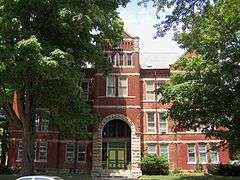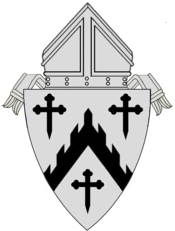St. Mary's Catholic Church (Davenport, Iowa)
| St. Mary's Catholic Church | |
|---|---|
 St. Mary's Catholic Church from Fillmore St | |
 | |
| Coordinates: 41°31′30.3″N 90°35′41.1″W / 41.525083°N 90.594750°W | |
| Location |
516 Fillmore St. Davenport, Iowa |
| Country | USA |
| Denomination | Roman Catholic |
| History | |
| Founded | July 21, 1867 |
| Founder(s) | Rev. J.A.M. Pelamourges |
| Dedication | Mary, mother of Jesus |
| Architecture | |
| Functional status | Active |
| Architectural type | Church |
| Groundbreaking | 1867 |
| Completed | 1867 |
| Construction cost | $25,000 |
| Administration | |
| Diocese | Davenport |
|
St. Mary's Roman Catholic Church Complex | |
| Area | 2.5 acres (1.0 ha) |
| Built |
1867-1868 (church) 1877 (rectory) 1901 (convent & school) |
| Architect |
Victor Hout (church) Clausen & Burrows (school & convent) |
| Architectural style |
Romanesque Revival Colonial Revival |
| MPS | Davenport MRA |
| NRHP Reference # | 84001558[1] |
| Added to NRHP | April 5, 1984 |
St. Mary's Catholic Church is a parish of the Diocese of Davenport. The church is located in the west end of Davenport, Iowa, United States, at the corner of Fillmore and W. 6th Streets. It is listed on the National Register of Historic Places as St. Mary's Roman Catholic Church Complex. The designation includes the church building and rectory on the west side of Fillmore Street, and the former parochial school building and convent on the east side. A former school building operated by the parish two blocks north on West Eighth Street is also on the National Register and is listed as St. Mary's Academy.
History
St. Mary's was established as a parish of the Diocese of Dubuque in 1867. The parish served the 150 English speaking Catholic families who lived in the city’s west end because the priest at St. Kunigunda, a German parish, refused to do so. St. Mary’s complex was built two blocks to the west of St. Kunigunda, later renamed St. Joseph.[2] Bishop John Hennessy laid the church's cornerstone on July 21, 1867. The church property was on the northeastern section of St. Mary's Cemetery, which was established by Bishop Mathias Loras in 1849.[3] The property for the cemetery was purchased from Judge C. G. R. Mitchell, who had also donated the land for St. Kunigunda. The church was built in 1867 for $25,000 and the parish paid $8,000 to build the rectory ten years later.[4]
Rev. J.A.M. Pelamourgues of St. Anthony’s Church downtown Davenport was its first pastor. The first resident pastor was the Rev. Maurice Flavin who came to St. Mary’s on May 10, 1868, and continued to serve the parish until 1871 when he was replaced with his brother, the Rev. Michael Flavin.[5] The parish became a part of the Diocese of Davenport when it was established in 1881.
In 1883 the church acquired a new pipe organ that was built by the Moline Pipe Organ Co.[6] One of the organist at the church was Célestine Fejérvary. She visited Europe ten years later and while she was in Belgium she acquired a painting by Guido Reni, the Assumption of the Blessed Virgin for St Mary’s.[6] Both the organ and the painting remain in the church.
In 1898 St. Mary’s helped establish a new parish in the northwest section of Davenport, Holy Family. The Redemptorists started St. Alphonsus Church to serve the working-class neighborhoods in the west end in 1908. From that year the parish boundaries for St. Mary’s were established.
At the turn on the 20th century the parish initiated a building project that established the school and convent across the street from the church and rectory. Both of the new buildings were completed in 1901 and they were designed by the Davenport architectural firm of Clausen & Burrows. The convent was completed for $7,000 and school for $19,000.[7] William Kelly served as the contractor for the convent and Coen & Company for the school.
In the late 1980s the city’s Spanish speaking community came to St. Mary’s. Liturgies are now celebrated in both English and Spanish.
Parochial school
The parish established a school a year after the parish was formed.[7] The church acted as the first school building. A larger school building used by the parish was built by the Rev. Michael Flavin two blocks to the north of the church. The Sisters of Mercy had already been teaching in the school when the new building opened.[4] The current school building was built by Msgr. J.P. Ryan directly across the street from the church in 1901.[8] The Sisters of the Holy Cross replaced the Mercy Sisters at this time.[9] Sister Mary Engelbart, OSC served as their first superior. The school was only for girls until 1931 when the high school girls began attending Immaculate Conception Academy.[7] The parish continued to support its own school until declining enrollments forced it to merge schools with neighboring St. Joseph parish. The merged school was named Holy Trinity and it continued into the 1990s when St. Mary’s ended the merger.
Architecture
The four buildings that form the parish complex sit across the street from each other and visually form a unified complex.[7] Their exteriors are all composed of a dark red brick, although the convent has subsequently been covered in vinyl siding. The church was built in the Romanesque Revival style, with a rectangular plan, decorative brickwork and a central bell tower.[2] The exterior features corbelling and brick pilasters on the sides that frame the tall narrow windows, which are capped by plain round-arched hoods. There is a concentration of ornamentation on the upper portion of the tower. It includes gablets with cross finials, round-arched louvers in the bellchamber and small oculi that are placed halfway up the spire.
The rectory was initially built in either the Italianate or Romanesque Revival style to match the church next door. Its style was changed about the time the convent and school were built in 1901.[7] They were both designed in the Colonial Revival style.
Pipe organ
Moline Organ Co. pipe organ (1883) features two manuals, 18 stops, slider chests and mechanical key action.
Stoplist:[10]
GREAT 58
|
SWELL 58
|
PEDALE 27
|
COUPLERS
|
COMPOSITION PEDALS
|
Gallery
- Rectory
- Convent
 First school building
First school building
References
- ↑ National Park Service (2009-03-13). "National Register Information System". National Register of Historic Places. National Park Service.
- 1 2 Svendsen, Marls A., Bowers, Martha H (1982). Davenport where the Mississippi runs west: A Survey of Davenport History & Architecture. Davenport, Iowa: City of Davenport. p. 12-1.
- ↑ "St. Mary's Cemetery Burials". Scott County Iowa USGenWeb Project. Retrieved 2010-03-03.
- 1 2 Merrill, J. G. "The History of the City of Davenport". Scott County Iowa USGenWeb Project. Retrieved 2010-09-08.
- ↑ "Chapter 20: Churches and Parishes". Scott County Iowa USGenWeb Project. Retrieved 2010-03-03.
- 1 2 "The History of Celestine Fejérváry and the Kárász (her Mother's) Family". Davenport Public Library. Retrieved 2011-04-17.
- 1 2 3 4 5 Martha Bowers, Marlys Svendsen-Roesler. "St. Mary's Roman Catholic Church Complex" (PDF). National Park Service. Retrieved 2014-10-25.
- ↑ Hinrichs, John G. "St. Mary's". Scott County Iowa USGenWeb Project. Retrieved 2010-09-08.
- ↑ "History of Davenport and Scott County". Scott County Iowa USGenWeb Project. Retrieved 2010-03-03.
- ↑ "Moline Organ Co., St. Mary's R.C. Church". OHS Pipe Organ Database. Retrieved 2013-08-19.
External links
| Wikimedia Commons has media related to St. Mary's Catholic Church (Davenport, Iowa). |
